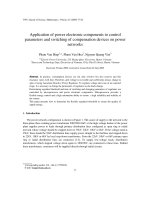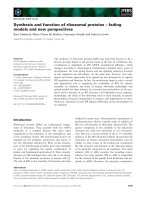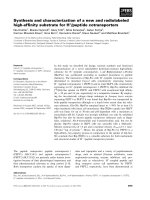Nanoscale metal-organic frameworks synthesis and application of bimodal micromeso-structure and nanocrystals with controlled size and shape
Bạn đang xem bản rút gọn của tài liệu. Xem và tải ngay bản đầy đủ của tài liệu tại đây (9.55 MB, 199 trang )
NANOSCALE METALORGANIC FRAMEWORKS:
SYNTHESIS AND APPLICATION OF BIMODAL MICRO/MESO-STRUCTURE
AND NANOCRYSTALS WITH CONTROLLED SIZE AND SHAPE
Thèse
MINH-HAO PHAM
Doctorat en génie chimique
Philosophiae Doctor (Ph.D.)
Québec, Canada
© Minh-Hao Pham, 2013
iii
Résumé
Les composés à réseau moléculaire organométalliques (MOFs) ont émergé comme de
nouvelles classes de matériaux hybrides organo-inorganiques avec des potentialités
significatives en séparation, stockage de gaz, catalyse et support de médicaments. Ces
lliques sont
2
g
1
et des volumes de pores supérieurs à 4.3 cm
3
g
1
. Dans cette thèse trois différentes
approches ont été développées pour la synthèse des nanocristaux MOFs à deux modes
micro-mésoporeux, ainsi que des nanocristaux MOFs à taille et forme contrôlable. En plus,
ces nanocristaux MOFs ont été utilisé comme un agent structurant pour la synthèse de
nanocomposite hybride platine-oxyde de titane (metal-oxideTiO
2
PtO
x
) qui ont été utilisé
visible.
Dans ce travail: (i) La première approche implique une méthode utilisant un surfactant,
suivi de traitement solvo-thermale en présence
nanocristaux MOFs micro- -ionique tell que
F127 (EO
97
PO
69
EO
97
) pour induire une structure mésoporeuse provoque labilité de la
cristallisation du mur des pores de la structure MOF.
acétique contrôle la vitesse de cristallisation du réseau MOFs pour former une
des nanocristaux de [Cu
3
(BTC)
2
] et [Cu
2
(HBTB)
2
] de structure mésoporeuse avec des
diamètres de pores autour de 4.0 nm et des micropores intrinsèques ont été synthétisés. (ii)
La méthodologie de modulation de la coordination a été développée pour contrôler la forme
et la taille des nanocristaux MOFs. Des nanocubes et nanofeuilles de [Cu
2
(ndc)
2
(dabco)]
n
pyridine ou la pyridine uniquement, respectivement comme modulateurs sélectifs. Ces
nanocristaux MOFs possèdent une cr
2
. (iii) La
synthèse hydrothermale en contrôlant la taille de nanocristaux de carboxylates de structure
iv
MOFs, en utilisant simultanément des réactifs stabilisants et des réactifs contrôlant la
déprotonation a été démontrée. Dans le cas de FeMIL-88BNH
2
, la molécule triblock
copolymer a été utilisée comme un réactif stabilisant en coordonnant avec le métal et
contrôlant la
un agent déprotonant des liants carboxyliques en variant sa concentration dans le milieu
réactionnel, ainsi il régule la vitesse de nucléation, conduisant à aussi contrôler la taille
ainsi que le rapport longueur/largeur des nanocristaux. (iv) Finalement, des nanocomposites
hybrides Fe
2
O
3
TiO
2
PtO
x
performante ont été développés en utilisant des nanocristaux FeMIL-88B composés de
centres Fe
3
(
3
O) liés par coordination insaturée comme template solide. Ce type de
nanocomposites non seulement absorbe la lumière visible mais aussi améliore la séparation
des électrons et des trous photo-les deux co-
catalyseurs (Fe
2
O
3
and PtO
x
) localisés sur deux opposites surfaces du creux. En
conséquence, l'efficacité en photocatalyse de ce type de nanocomposites est élevée pour la
production d'H
2
à partir de l'eau sous la lumière visible.
v
Abstract
Metalorganic frameworks (MOFs) have emerged as an important new class of porous
inorganicorganic hybrid solids with the potential for a significant impact on separation,
gas storage, catalysis and biomedicine. These materials are formed by assembly process in
which metal ions are linked together by rigid organic ligands, which creates enormous
surface areas (up to 6500 m
2
g
1
) and high pore volumes (up to 4.3 cm
3
g
1
). In this thesis,
three different synthetic approaches have been developed to achieve bimodal
micro/mesoporous MOF nanocrystals as well as nanosized MOFs with controlled size and
shape. In addition, using the synthesized MOF nanocrystals as templates, a new hollow
hybrid metal-oxideTiO
2
PtO
x
nanocomposite has also been prepared, and used as the
visible-light driven photocatalyst for the hydrogen production from water.
In this work, (i) the first approach involves nonionic surfactant-templated solvothermal
synthesis in the presence of acetic acid toward hierarchically micro-mesoporous MOF
nanocrystals. The use of a nonionic surfactant such as F127 (EO
97
PO
69
EO
97
) as
mesostructure template induces the ability to crystallize a MOF structure of pore wall,
while the presence of acetic acid allows control of the crystallization rate of the framework
to form well-defined mesostructures within the crystalline MOF nanocrystals. Using this
approach, [Cu
3
(BTC)
2
] and [Cu
2
(HBTB)
2
]-based MOF nanocrystals containing mesopores
with diameter around 4.0 nm and intrinsic micropores have been successfully synthesized.
(ii) Secondly, the coordination modulation methodology has been developed to control
shape and size of MOF crystals at the nanoscale. Nanocubes and nanosheets of
[Cu
2
(ndc)
2
(dabco)]
n
MOF have been rationally synthesized by using simultaneously acetic
acid and pyridine or only pyridine, respectively, as selective modulators. These MOF
nanocrystals exhibit high crystallinity and high CO
2
sorption capacity. Their morphology-
dependent CO
2
sorption property has also been demonstrated. (iii) Thirdly, the size-
controlled hydrothermal synthesis of uniform carboxylate-based MOF nanocrystals using
simultaneously stabilizing reagent and deprotonation-controlled reagent has been
demonstrated. In case of FeMIL-88BNH
2
, the molecular triblock copolymers as
stabilizing reagents coordinate with the metal ions and thus stabilize nuclei, which suppress
vi
the crystal growth to form nanocrystals. Acetic acid as deprotonation-controlled reagent
adjusts the deprotonation of the carboxylic linker via varying its concentration in the
reaction mixture, and thus regulates the rate of nucleation, leading to tailoring the size and
aspect ratio (length/width) of the nanocrystals. (iv) Finally, a new hollow hybrid metal-
oxideTiO
2
PtO
x
nanocomposite as an efficient photocatalyst has been developed by using
iron-based MIL-88B nanocrystals consisting of coordinatively unsaturated Fe
3
3
O)
clusters as template. The hollow nanocomposite not only absorbs visible light, but also
enhances the separation between photogenerated electrons and holes because of its thin
wall and the surface separation of two distinct functional cocatalysts (Fe
2
O
3
and PtO
x
) on
two different surface sides of the hollow. As a result, the efficient photoactivity of the
nanocomposite photocatalysts has been found for the H
2
production from water under
visible light irradiation.
vii
Table of Contents
Résumé iii
Abstract v
Abbreviations ix
Acknowledgements xi
Preface xiii
Chapter 1 Introduction 1
1.1 General introduction 1
1.2 Objectives of the thesis 2
1.3 References 3
Chapter 2 Literature Review 5
2.1 Metalorganic frameworks 5
2.2 Mesoporous metal-organic frameworks 13
2.2.1 MOFs with mesocages 13
2.2.2 MOFs with mesochannels 21
2.2.3 Mesoporous MOFs from supramolecular templates 26
2.2.4 Prospective applications of MOFs involving mesopores 30
2.3 Nanosized metal-organic frameworks 33
2.3.1 Coordination modulation 34
2.3.2 Stabilizing reagent 36
2.3.3 Microemulsion 38
2.3.4 Synthetic parameters 41
2.3.5 Top-down approach 44
2.3.6 Potential application of MOFs involving nanosize 45
2.4 Photocatalytic water splitting 51
2.5 References 54
Chapter 3 Characterizations 65
3.1 Introduction 65
3.2 X-ray diffraction 65
3.3 Electron microscopy 67
3.4 X-ray photoelectron spectroscopy 69
3.5 Fourier transform infrared spectroscopy 71
3.6 Ultraviolet-visible spectroscopy 72
3.7 -Potential analysis 73
3.8 Thermal analysis 74
3.9 Elemental analysis 75
3.10 Gas sorption 76
3.10.1 Physisorption isotherm and surface area measurement. 76
viii
3.10.2 Micropore analysis 78
3.10.3 Size distribution of mesopores 80
3.11 Gas chromatography analysis 81
3.12 References 81
Chapter 4 Route to Bimodal MicroMesoporous MOF Nanocrystals 83
4.1 Introduction 89
4.2 Experimental 90
4.3 Results and discussion 91
4.4 Conclusions 100
4.5 Appendix 101
4.6 References 104
Chapter 5 Rational Synthesis of MOF Nanocubes and Nanosheets Using Selective
Modulators and Their Morphology-Dependent Gas-Sorption Properties 107
5.1 Introduction 113
5.2 Experimental 115
5.3 Results and discussion 117
5.4 Conclusions 123
5.5 Appendix 123
5.6 References 126
Chapter 6 Novel Route to Size-Controlled FeMIL-88BNH
2
MOF Nanocrystals 129
6.1 Introduction 135
6.2 Experimental 137
6.3 Results and discussion 139
6.4 Conclusions 150
6.5 Appendix 151
6.6 References 152
Chapter 7 Hollow Fe
2
O
3
TiO
2
–PtO
x
Nanostructure with Two Distinct Cocatalysts
Embedded Separately on Two Surface Sides for Efficient Visible Light Water
Splitting to Hydrogen 157
7.1 Introduction 163
7.2 Results and discussion 166
7.3 Conclusions 172
7.4 Experimental 172
7.5 Appendix 175
7.6 References 179
Chapter 8 Conclusions and Prospects 181
8.1 General conclusions 181
8.2 Prospects 182
List of Publications 185
ix
Abbreviations
AAS Atomic absorption spectroscopy
BDC 1,4-benzenedicarboxylic acid
BET BrunauerEmmettTeller
BJH BarrettJoynerHalenda
BPDC -biphenyldicarboxylic acid
BPY -bipyridine
BTB 1,3,5-tris[4-carboxyphenyl]benzene
BTC 1,3,5-benzenetricarboxylic acid
BTE -(benzene-1,3,5-triyl-tris(ethyne-2,1-diyl))tribenzoate
BTTC Benzo-(1,2;3,4;5,6)-tris(thiophene--carboxylate)
CB Conduction band
cbIM 5-chlorobenzimidazole
CTAB Cetyltrimethylammonium bromide
DABCO 1,4-diaza-bicyclo[2.2.2]octane
DBA 4-(dodecyloxy)benzoic acid
DMF N,N-dimethylformamide
DOT 2,5-dioxidoterephthalate
EDS Energy dispersive X-ray spectroscopy
FTIR Fourier transform infrared spectroscopy
GC Gas chromatography
H
6
L 1,3,5---biphenyl]-4-yl)benzene
IUPAC International Union of Pure and Applied Chemistry
x
MOF Metalorganic framework
MTN Mobil thirty-nine
NDC 1,4-naphthalenedicarboxylic acid
2,6-NDC 2,6-naphthalenedicarboxylic acid
N-EtFOSA N-ethyl peruorooctylsulfonamide
NHE Normal hydrogen electrode
PCP Porous coordination polymer
PTEI 5,5'-((5'-(4-((3,5-dicarboxyphenyl)ethynyl)phenyl)-[1,1':3',1''-terphenyl]-4,4''-
diyl)-bis(ethyne-2,1-diyl))diisophthalate
SAXS Small angle X-ray scattering
SBU Secondary building unit
SDC 4,4'-stilbenedicarboxylic acid
SEM Scanning electron microscopy
ST Super tetrahedron
TATAB -s-triazine-1,3,5-triyltri-p-aminobenzoate
TATB -s-trizaine-2,4,6-triyltribenzoic
TCPP Tetrakis(4-carboxyphenyl)porphyrin
TEM Transmission electron microscopy
T
2
DC Thieno[3,2-b]thiophene-2,5-dicarboxylate
TTEI 5,5',5''-(((benzene-1,3,5-triyltris(ethyne-2,1-diyl))tris(benzene-4,1-diyl))tris-
(ethyne-2,1-diyl))triisophthalate
UV-vis Ultraviolet-visible spectroscopy
VB Valence band
XPS X-ray photoelectron spectroscopy
XRD X-ray diffraction
xi
Acknowledgements
Firstly, I would like to thank Professor Trong-On Do for his excellent supervision and
guidance throughout the entirety of my PhD program. I am also sincerely grateful to
Professor Fr-Georges Fontaine at Université Laval for giving me the opportunity to
work with him. I gratefully acknowledge Professor Peter McBreen at Université Laval,
Professor James D. Wuest at Université de Montréal for their useful discussions.
I am very grateful for the generous and contentious help from the present and the former
members of the Do group and from my other colleagues at the Département de Génie
chimique of Université Laval. I wish to give thanks to all the professors and staff at the
Département de Génie chimique for their great assistance and cooperation. I am also
grateful to the technicians at Université Laval for providing advice and instructions to
operate equipments which I have used during my PhD studies.
I am most indebted to my family, especially my wife and my lovely daughter for their
unconditional love and invaluable support. I also thank my friends and acquaintances for
great and impressive time during my stay in Canada.
Finally, I would like to thank Vietnam Ministry of Education and Training for a
scholarship; the Natural Sciences and Engineering Research Council of Canada (NSERC),
the Centre en catalyse et chimie verte (C3V, Universi
additional financial support.
Without all of you, it would not have been possible to realise this thesis.
Thank you.
xiii
Preface
This PhD thesis is built in the form of a collection of scientific papers whose first author is
the submitter of this thesis. The papers have been published or submitted for publication at
the time of the thesis submission.
The thesis is divided into eight chapters. The objectives of the thesis are elaborated in
chapter 1 after a brief general introduction. The literature review relating to the objectives
is thus presented in chapter 2, in which the background of metalorganic frameworks
(MOFs), the concepts and synthetic strategies toward mesoporous MOFs as well as the
prospective applications involving mesopore, the synthetic methodologies toward
nanosized MOFs and the potential applications involving nanosize, the photocatalytic water
splitting are reviewed. Chapter 3 outlines the background of characterizations that were
applied during the performing of this PhD work.
Chapter 4 reports the nonionic surfactant-templated solvothermal method in the presence of
acetic acid to achieve hierarchically porous MOF nanocrystals containing well-defined
mesopores with diameter around 4.0 nm and intrinsic micropores. The writing of this
chapter was supervised by Prof. Trong-On Do and Prof. -Georges Fontaine who are
the co-authors. Part of the characterizations used in this research was conducted in
collaboration with Mr. Gia-Thanh Vuong who is also the co-author. This research is
published in Crystal Growth & Design 2012, 12, 10081013.
Chapter 5 presents the rational synthesis of nanocubes and nanosheets of
[Cu
2
(ndc)
2
(dabco)]
n
MOF by using simultaneously acetic acid and pyridine or only
pyridine, respectively, as selective modulators. The morphology-dependent CO
2
sorption
property of these nanocrystals is also discussed in this chapter. The writing of this chapter
was supervised by Prof. Trong-On Do and Prof. -Georges Fontaine who are the co-
authors. Part of the characterizations used in this chapter was conducted in collaboration
with Mr. Gia-Thanh Vuong who is also the co-author. This chapter is published in Crystal
Growth & Design 2012, 12, 30913095.
xiv
Chapter 6 reports the size-controlled hydrothermal approach toward uniform FeMIL-
88BNH
2
nanocrystals with crystal size in the range of 30150 nm in width and of 50500
nm in length by using simultaneously F127 triblock copolymer as stabilizing reagent and
acetic acid as deprotonation-controlled reagent. The writing of this chapter was supervised
by Prof. Trong-On Do who is the co-author. Part of the characterizations used in this
research was conducted in collaboration with Mr. Gia-Thanh Vuong and Dr. Anh-Tuan Vu
who are also the co-authors. This chapter is published in Langmuir 2011, 17, 1526115267.
Chapter 7 studies the application of the prepared FeMIL-88BNH
2
nanocrystals as
template to constructing a new hollow hybrid metal-oxideTiO
2
PtO
x
nanocomposite as
the efficient photocatalyst for H
2
production from water under visible light irradiation. The
writing of this chapter was supervised by Prof. Trong-On Do who is the co-author. Part of
the characterizations used in this research was conducted in collaboration with Mr. Cao-
Thang Dinh, Mr. Gia-Thanh Vuong and Prof. Ngoc-Don Ta who are also the co-authors.
This study has been submitted to a refereed journal.
Finally, Chapter 8 completes the thesis by summarizing general conclusions and prospects
for future work.
1
Chapter 1 Introduction
1.1 General introduction
Over the past two decades, there has been an enormous progress in research on porous
inorganicorganic hybrid materials that are known as metalorganic frameworks (MOFs)
or porous coordination polymers (PCPs).
1-4
The phrase
was defined by Omar Yaghi et al. is now widely employed for porous crystalline structures
constructed from the coordinative bonding between metal ions and rigid organic linkers.
5,6
MOFs have revealed various potential applications in separation,
7,8
gas storage,
9,10
catalysis,
11,12
sensing,
13
magnetic field,
14
and biomedicine.
15
The prospective applications
of MOFs are accounted for their stable framework,
16
high porosity with enormous surface
area and pore volume,
17,18
the ability to systematically vary and functionalize their pore
structure,
19,20
and to rationally achieve pre-determined topologies with desired properties.
21
Most of MOFs are microporous materials (pore size of < 2 nm) with large crystal sizes in
the micrometer scale. The small apertures of the micropores and the large crystal sizes of
MOFs significantly limit extensive applications of MOFs, especially in the participation of
large substances such as enzymes or in applications requiring nanoscale sizes such as drug
delivery.
22,23
Moreover, the long micropores within MOF microcrystals also induce
diffusion resistance to adsorbed guest molecules. To upgrade the performance of MOFs,
several strategies to enlarge their pore size toward the mesopore regime (pore size of 250
nm)
24,25
and to downsize their crystal size to the nanometer scale have thus emerged.
26
The
mesopores and nanosizes promote the diffusion of guest molecules through MOFs and
increase accessible active sites.
27
Furthermore, the mesopores also allow complex
substances to be encapsulated within MOF crystals. The MOF nanocrystals exhibit various
interesting features that are not observed in the bulk MOF materials such as unprecedented
adsorption, processability and guest inclusion.
28
Several attempts to create mesopores within MOFs have been reported. The enlargement of
the organic linkers allows the expansion of the pore size of MOFs to the mesopore
2
regime.
29
However, the obtained mesopore structures are usually collapsed upon the
removal of guest molecules. In many cases, the linker extension only forms catenated MOF
structures (i.e., interpenetration or interweaving of two or more identical and independent
frameworks) that have smaller pores rather than their non-catenated counterparts.
30
The
surfactant-templated syntheses which employ the principle of the templated routes to
synthesis of conventional mesoporous materials have been adopted to generate mesopores
within MOF particles. However, the mesoporous MOFs have large particle size,
31
or an
unidentifiable crystalline structure of pore wall.
32
Similarly, various approaches have been used for synthesizing nanosized MOFs. The
microwave- and ultrasound-assisted syntheses produce MOF nanoparticles in a short period
of time.
33
The MOF nanoparticles have also been synthesized by using microemulsion
systems.
34
Stabilizing- and capping-reagents have been employed to suppress the crystal
growth of MOFs which lead to nanosized MOFs.
35
But in general, it is difficult to control
the shape and size of MOF nanoparticles and the resulted nanoparticles usually appear as
aggregation rather than individual nanocrystals.
36
Up to date, there is a great challenge to the preparation of mesoporous MOF nanocrystals
and uniform nanoscale MOFs with desired shape and size.
1.2 Objectives of the thesis
The aim of this thesis is to develop synthetic methods for preparing bimodal micro- and
meso-porous MOF nanocrystals, uniform nanosized MOFs with controlled-shape and size
and subsequently, the extensive application of the prepared nanosized MOFs.
The first objective is nonionic surfactant-templated solvothermal method in the presence of
acetic acid to achieve hierarchically porous MOF nanocrystals containing well-defined
mesopores and intrinsic micropores. The roles of the nonionic surfactant template and
acetic acid in forming well-defined mesostructures as well as influencing the size and
crystallinity of the hierarchically porous MOF nanoparticles have been demonstrated.
3
The second objective is coordination modulation methodology using simultaneously
distinct selective modulators or only one selective modulator for controlling rationally the
morphology of MOF nanocrystals. The effects of the nature and the concentration of
selective modulators on the shape and size of MOF nanocrystals have been demonstrated.
In addition, the morphology-dependent CO
2
sorption property has also been illustrated.
The third objective is hydrothermal approach using simultaneously stabilizing reagent and
deprotonation-controlling reagent for the preparation of uniform nanosized carboxylate-
based MOFs with desired crystal sizes. The control of the stabilizing reagent and
deprotonation-controlling reagent over the size of the nanosized MOFs has been
demonstrated.
Finally, after the successful synthesis, the extensive application of the nanosized MOFs to
preparing a new hollow hybrid nanocomposite as an efficient photocatalyst for H
2
production from water under visible light irradiation is the last objective of this dissertation.
1.3 References
(1) Ferey, G. Chem. Soc. Rev. 2008, 37, 191-214.
(2) Long, J. R.; Yaghi, O. M. Chem. Soc. Rev. 2009, 38, 1213-1214.
(3) Zhou, H. C.; Long, J. R.; Yaghi, O. M. Chem. Rev. 2012, 112, 673-674.
(4) Kitagawa, S.; Kitaura, R.; Noro, S i. Angew. Chem. Int. Ed. 2004, 43, 2334-2375.
(5) Yaghi, O. M., Li, G., Li, H. Nature 1995, 378, 703-706.
(6) Batten, S. R.; Champness, N. R.; Chen, X M.; Garcia-Martinez, J.; Kitagawa, S.;
Öhrström, L.; O'Keeffe, M.; Suh, M. P.; Reedijk, J. CrystEngComm 2012, 14, 3001-
3004.
(7) Li, J. R.; Sculley, J.; Zhou, H. C. Chem. Rev. 2012, 112, 869-932.
(8) Maes, M.; Schouteden, S.; Hirai, K.; Furukawa, S.; Kitagawa, S.; De Vos, D. E.
Langmuir 2011, 27, 9083-9087.
(9) Suh, M. P.; Park, H. J.; Prasad, T. K.; Lim, D. W. Chem. Rev. 2012, 112, 782-835.
(10) Wu, H.; Gong, Q.; Olson, D. H.; Li, J. Chem. Rev. 2012, 112, 836-868.
(11) Yoon, M.; Srirambalaji, R.; Kim, K. Chem. Rev. 2012, 112, 1196-1231.
(12) Corma, A.; García, H.; Llabrés i Xamena, F. X. Chem. Rev. 2010, 110, 4606-4655.
(13) Kreno, L. E.; Leong, K.; Farha, O. K.; Allendorf, M.; Van Duyne, R. P.; Hupp, J. T.
Chem. Rev. 2012, 112, 1105-1125.
4
(14) Zhang, W.; Xiong, R. G. Chem. Rev. 2012, 112, 1163-1195.
(15) Horcajada, P.; Gref, R.; Baati, T.; Allan, P. K.; Maurin, G.; Couvreur, P.; Ferey, G.;
Morris, R. E.; Serre, C. Chem. Rev. 2012, 112, 1232-1268.
(16) Eddaoudi, M.; Li, H.; Yaghi, O. M. J. Am. Chem. Soc. 2000, 122, 1391-1397.
(17) Furukawa, H.; Ko, N.; Go, Y. B.; Aratani, N.; Choi, S. B.; Choi, E.; Yazaydin, A. Ö.;
Science 2010, 329, 424-428.
(18) An, J.; Farha, O. K.; Hupp, J. T.; Pohl, E.; Yeh, J. I.; Rosi, N. L. Nat. Commun. 2012,
3, #604, 1-6.
(19) Cohen, S. M. Chem. Rev. 2011, 112, 970-1000.
(20) Tanabe, K. K.; Wang, Z.; Cohen, S. M. J. Am. Chem. Soc. 2008, 130, 8508-8517.
(21) M. Chem. Rev. 2011, 112, 675-702.
(22) Deng, H.; Grunder, S.; Cordova, K. E.; Valente, C.; Furukawa, H.; Hmadeh, M.;
Terasaki, O.; Stoddart, J. F.; Yaghi, O. M. Science 2012, 336, 1018-1023.
(23) Horcajada, P.; Chalati, T.; Serre, C.; Gillet, B.; Sebrie, C.; Baati, T.; Eubank, J. F.;
Heurtaux, D.; Clayette, P.; Kreuz, C.; Chang, J S.; Hwang, Y. K.; Marsaud, V.;
Bories, P N.; Cynober, L.; Gil, S.; Ferey, G.; Couvreur, P.; Gref, R. Nat. Mater.
2010, 9, 172-178.
(24) Song, L.; Zhang, J.; Sun, L.; Xu, F.; Li, F.; Zhang, H.; Si, X.; Jiao, C.; Li, Z.; Liu, S.;
Liu, Y.; Zhou, H.; Sun, D.; Du, Y.; Cao, Z.; Gabelica, Z. Energy Environ. Sci. 2012,
5, 7508-7520.
(25) Xuan, W.; Zhu, C.; Liu, Y.; Cui, Y. Chem. Soc. Rev. 2012, 41, 1677-1695.
(26) Flügel, E. A.; Ranft, A.; Haase, F.; Lotsch, B. V. J. Mater. Chem. 2012, 22, 10119-
10133.
(27) Uehara, H.; Diring, S.; Furukawa, S.; Kalay, Z.; Tsotsalas, M.; Nakahama, M.; Hirai,
K.; Kondo, M.; Sakata, O.; Kitagawa, S. J. Am. Chem. Soc. 2011, 133, 11932-11935.
(28) Uemura, T.; Kitagawa, S. Chem. Lett. 2005, 34, 132-137.
(29) Eddaoudi, M.; Kim, J.; Rosi, N.; Vodak, D.; Wachter, J.; O'Keeffe, M.; Yaghi, O. M.
Science 2002, 295, 469-472.
(30) Farha, O. K.; Malliakas, C. D.; Kanatzidis, M. G.; Hupp, J. T. J. Am. Chem. Soc.
2009, 132, 950-952.
(31) Ma, T Y.; Li, H.; Deng, Q F.; Liu, L.; Ren, T Z.; Yuan, Z Y. Chem. Mater. 2012,
24, 2253-2255.
(32) Zhao, Y.; Zhang, J.; Han, B.; Song, J.; Li, J.; Wang, Q. Angew. Chem. Int. Ed. 2011,
50, 636-639.
(33) Li, Z Q.; Qiu, L G.; Xu, T.; Wu, Y.; Wang, W.; Wu, Z Y.; Jiang, X. Mater. Lett.
2009, 63, 78-80.
(34) Taylor, K. M. L.; Rieter, W. J.; Lin, W. J. Am. Chem. Soc. 2008, 130, 14358-14359.
(35) Hermes, S.; Witte, T.; Hikov, T.; Zacher, D.; Bahnmüller, S.; Langstein, G.; Huber,
K.; Fischer, R. A. J. Am. Chem. Soc. 2007, 129, 5324-5325.
(36) Qiu, L. G.; Li, Z. Q.; Wu, Y.; Wang, W.; Xu, T.; Jiang, X. Chem. Commun. 2008,
3642-3644.
5
Chapter 2 Literature Review
2.1 Metalorganic frameworks
MOFs are porous crystalline materials with hybrid frameworks built from the linkages of
metal ions with organic linkers.
1-3
The functional groups of the organic linkers for
coordinative bonding to the metal ions and the coordination geometry of the metal nodes
(metal ions or metal-containing clusters) play a decisive role in the formation of the
topologies of MOF structures. The appropriate groups are carboxylate, heterocyclic
nitrogen, amine, nitrile, phosphonate and sulfonate (Figure 2.1).
4-8
Among them,
carboxylate group is the most commonly used functionality for designing and constructing
MOF structures.
9,10
Multitopic linkers (i.e., containing two or more functional groups) with
rigid carbon backbones favor prominently in the quest for stable and robust frameworks
that retain MOF integrity in the absence of guest molecules. The rigid carbon backbones
are usually aromatic chains or alkenyl chains with double bonds. Metalloligands are also
used as linkers for the construction of MOFs.
11-16
Furthermore, the linkers can
organic molecules, but in some cases they tend to give MOF structures in the form of dense
packing or interpenetration.
17-19
Ditopic linkers
1,4-benzenedicarboxylic acid 1,4-diaza-bicyclo[2.2.2]octane 1,5-naphthalenedisulfonic acid
N,N
-phenylenebis(salicylideneimine)dicarboxylic acid Bis[3-(4-pyridyl)pentane-2,4-dionato]copper(II)
6
Tritopic linkers
1,3,5-benzenetricarboxylic acid 2,4,6-tris(4-pyridyl)-1,3,5-triazine 1,3,5-benzenetriphosphonic acid
Tetratopic linkers
1,3,5,7-adamantanetetrabenzoic acid Tetrakis[4-(carboxyphenyl)oxamethyl]methane
1,3,5,7-tetrakis(4-phosphonophenyl)adamantine Tetrakis(4-cyanophenyl)methane
Figure 2.1 Multitopic organic linkers for MOF construction.
4-16
The metal ions constructing MOF structures possess several coordination numbers. The
first row transition metal ions such as Cr
3+
, Fe
3+
, Cu
2+
and Zn
2+
are widely used for
constructing MOFs.
10,20
The coordination of the functional groups of organic linkers to the
metal ions often generates polyatomic clusters containing two or more metal atoms, so-
7
called secondary building units (SBUs). The SBUs give points of extension where they
connect to the rigid carbon backbones of the organic linkers to form porous structures. The
geometry of the SBUs is determined by the coordination number, coordination geometry of
the metal ions and the nature of the functional groups. The variety of SBU geometries with
different numbers of points of extension has been observed in MOF structures.
10,21
However, the metal-containing SBUs are not isolatable entities, and so it is essential to
establish exact chemical conditions that will yield a specific SBU in situ.
8
Octahedron (6 points) Trigonal prism (6 point) Square paddle-wheel (4 points)
Triangle (3 points) Square pyramid (5 points) Cube (8 points)
Figure 2.2 Geometry and number of points of extension of representative SBUs. Metal:
polyhedral; C: black; O: red; Heteroatom: green, cyan. Reproduced with the permission of
The Royal Society of Chemistry.
10
The most common SBUs are clusters of metal ions and carboxylate groups. The typical
examples are octahedral, trigonal prism and square paddle-wheel SBUs (Figure 2.2).
10
The
octahedral SBU with the formula of M
4
O(COO)
6
consists of a central bridging O atom
bonding to four tetrahedral metal atoms to form a tetrahedral M
4
O unit; and six carboxylate
groups connecting the edges of the tetrahedra. The six points of extension (i.e., six carbon
atoms of the carboxylate groups) are at the vertices of the octahedron. This cluster is found
for Zn, Co and Be. In case of trigonal prism SBU with the formula of M
3
O(COO)
6
, three
metal ions connect together via a central bridging O atom and each pair of the octahedral
8
metal atoms is bridged by two carboxylate groups. Each metal ion coordinates to a terminal
ligand such as solvent or anion. The six points of extension locate at the vertices of the
trigonal prism. This SBU is observed for several metals such as Cr, Fe and Al. In the square
paddle-wheel SBU, two metal ions are bridged by four carboxylate groups and each metal
ion is coordinated by a terminal ligand on the apical position. This structure is represented
by Cu
2
(COO)
4
SBU.
The connection between the metal-containing SBUs via the carbon backbones of organic
linkers forms porous crystalline structures of MOFs.
22
The judicious use of appropriately
shaped SBUs and rigid organic linkers results in the formation of pre-determined MOF
topologies.
23,24
The well-known example is the design and preparation of MOF-5
framework.
25
In this framework, the zinc-carboxylate SBUs with six points of extension in
octahedral geometries connect to phenyl rings of 1,4-benzenedicarboxylic (BDC) acids to
form porous cubic structure (Figure 2.3).
Figure 2.3 MOF-5 built from the connection of the octahedral SBUs with BDC acids. C:
gray; O: red; Zn: blue tetrahedral. All hydrogen atoms are omitted for clarity. The large
yellow sphere represents the largest van der Waals sphere that fits in the cavity of the
framework. Reproduced with the permission of Nature Publishing Group.
25
In principle, an almost unlimited number of MOFs can be constructed due to a great
diversity of organic linkers and metal-containing SBUs. The connection of a specific SBU
with different organic linkers and vice versa leads to MOF structures with different
+
MOF-5
Zn
4
O(COO)
6
Octahedral SBU
C
6
H
4
Moiety
9
topologies. The illustrative example is shown in Figure 2.4. The connection of trigonal
prism SBUs with different organic linkers, either BDC acids as ditopic linker or 1,3,5-
benzenetricarboxylic (BTC) acids as tritopic linker, creates the different topologies of MIL-
88B and MIL-100 (MIL standing for Materials of the Institute Lavoisier).
26,27
In the other
hand, the connection of the same tritopic BTC linkers with dicopper square paddle-wheel
SBUs instead of trigonal prism SBUs results in HKUST-1 topology (HKUST standing for
Hong Kong University of Science and Technology).
28
As a result, the features of the
resulted frameworks such as pore structure, porosity, rigidity of the frameworks and
physicochemical properties are also different.
Figure 2.4 Topologies of MOFs from the different connections between SBUs and organic
linkers. C: gray; O: red, Cu: cyan; metal such as Cr, Fe: green. Reproduced with the
permission of The Royal Society of Chemistry, Willey and Elsevier.
26-28
Functional groups such as NH
2
, NO
2
, SO
3
H, CN, OH, OC
x
H
y
, C
x
H
y
, CF
3
,
COOH, azide (N
3
) and halogens have been attached on organic linkers, commonly
aromatic linkers, to generate functionalized MOFs.
29-38
The functionalized MOFs are often
MIL-88B
MIL-100
HKUST-1
10
monofunctional structures containing a single type of functional groups. The introduction
of functional groups creates isoreticular MOFs with the same network, such as IRMOF-n (n
= 2 5) possessing the network of IRMOF-1 (or MOF-5).
33
The functional groups can
improve the stability and tailor the property of the parent structures for interesting
applications. Multifunctional MOFs containing two or more distinct chemical
functionalities have also been fabricated by integrating several organic linkers into a single
platform.
39-41
The multifunctional MOFs provide integrated properties that their
monofunctional counterparts can not achieve.
42
MOF structures can be built from two or more types of organic linkers instead of one type
of linker.
43-46
In the example to [M
2
(dicarboxylate)
2
(N ligand)]
n
MOFs, the three dimension
structure of [Cu
2
(ndc)
2
(dabco)]
n
MOF is built from the connection of dicopper square
paddle-wheel SBUs with two distinct linkers, including 1,4-naphthalene dicarboxylic (ndc)
acid and 1,4-diaza-bicyclo[2.2.2]octane (dabco).
47
In this structure, NDC molecules
connect with dicopper square paddle-wheel SBUs to form two dimension square lattices
that are connected together by dabco molecules at the lattice points to form the porous
structure (Figure 2.5).
Figure 2.5 Structure of [Cu
2
(ndc)
2
(dabco)]
n
. Cu: blue; N: green; O: red; and C: gray. All
hydrogen atoms are omitted for clarity. Reproduced with the permission of Elsevier.
48
The crystalline structures of MOFs are normally quite rigid. However, the reversible
structural variation with retained topology can occur in various MOFs under external
stimuli. Such variation of the flexible frameworks is usually called breathing effect.
49-51
11
The breathing effect is activated by the presence of inserted guests such as water, solvents
and gases. The breathing amplitude is governed by the host-guest interaction and the
flexibility of MOF skeleton. The structural variation results in a dynamic change in the pore
size and shape. During the breathing, the position of the Bragg peaks in the X-ray
diffraction powder pattern shifts as a result of the change of the unit cell parameters.
The large breathing effect has been found in some carboxylate-based MOFs such as MIL-
88 structures (MIL-88A constructed from fumaric acid, MIL-88B from BDC acid, MIL-
88C from 2,6-naphthalenedicarboxylic (2,6-NDC) acid and MIL-88D from -
biphenyldicarboxylic (BPDC) acid),
27,52,53
MIL-53,
54-58
MIL-89,
59
DUT-8,
60
MCF-18,
61
and
DMOF-1.
62,63
The possible breathing of a carboxylate-based MOF occurs only if structural
rules are all .
49
The rules include the existence of a mirror plane in the SBU with
the carboxylates in symmetrical positions toward them, for example in the square paddle-
wheel dimers of DMOF-1 and the trigonal prism trimers of MIL-88; ditopic linker; and the
absence of rigid odd cycles. Therefore, at variance to MIL-88, MIL-53 and DMOF-1; MIL-
101 owning pentagonal windows,
64
MOF-5 consists of tetragonal SBUs without the mirror
planes,
25
and HKUST-1 constructed from tritopic linkers
28
do not breath. Moreover, it
seems that the ratio of number of carbons of the carboxylates surrounding the SBU to
number of metal atoms within the SBU must be greater than or equal to 2 for such
breathing effect.
In the illustrative example based on MIL-88B,
65
the topology has large cages with a
trigonal bipyramid shape. The vertices of the bipyramid are occupied by trigonal prism
SBUs. The ditopic linkers are on the edges of the bipyramid and there is no link in the
equatorial plane of the bipyramind. The SBUs can rotate around the knee cap OO axes of
the carboxylates and the OOCCOO axes of the linkers (Figure 2.6, left). These rotations
accompanying with the absence of rigid linkages between the equatorial SBUs can induce a
change in the distance between the equatorial SBUs under external stimuli, leading to
breathing effect. Indeed, the as-synthesized form of MIL-88B contains a few solvent
molecules in the bipyramid cage. When the solvents are removed from the cage (dry form),
the length between the two non-equatorial SBUs increases whereas the distance between
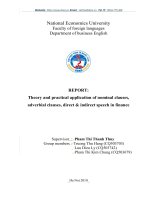

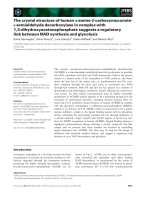
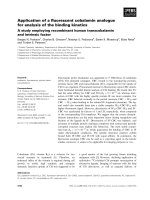
![Tài liệu Báo cáo khoa học: Specific targeting of a DNA-alkylating reagent to mitochondria Synthesis and characterization of [4-((11aS)-7-methoxy-1,2,3,11a-tetrahydro-5H-pyrrolo[2,1-c][1,4]benzodiazepin-5-on-8-oxy)butyl]-triphenylphosphonium iodide doc](https://media.store123doc.com/images/document/14/br/vp/medium_vpv1392870032.jpg)

